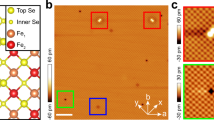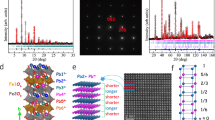Abstract
Charge-ordering is an important phenomenon in conducting metal oxides: it leads to metal–insulator transitions1 in manganite perovskites (which show ‘colossal’ magnetoresistances), and the Verwey2 transition in magnetite (in which the material becomes insulating at low temperatures when the conduction electrons freeze into a regular array). Charge-ordered ‘stripes’ are found in some manganites3,4 and copper oxide superconductors5; in the latter case, dynamic fluctuations of the stripes have been proposed6 as a mechanism of high-temperature superconductivity. But an important unresolved issue is whether the charge-ordering in oxides is driven by electrostatic repulsions between the charges (Wigner crystallization7), or by the strains arising from electron–lattice interactions (such as Jahn–Teller distortions) involving different localized electronic states. Here we report measurements on iron oxoborate, Fe2OBO3, that support the electrostatic repulsion charge-ordering mechanism: the system adopts a charge-ordered state below 317 K, in which Fe2+ and Fe3+ ions are equally distributed over structurally distinct Fesites. In contrast, the isostructural manganese oxoborate, Mn2OBO3, has been previously shown8 to undergo charge-ordering through Jahn–Teller distortions. We therefore conclude that both mechanisms occur within the same structural arrangement.
This is a preview of subscription content, access via your institution
Access options
Subscribe to this journal
Receive 51 print issues and online access
$199.00 per year
only $3.90 per issue
Buy this article
- Purchase on Springer Link
- Instant access to full article PDF
Prices may be subject to local taxes which are calculated during checkout




Similar content being viewed by others
References
Rao, C. N. R. & Cheetham, A. K. Giant magnetoresistance, charge-ordering, and related aspects of manganates and other oxide systems. Adv. Mater. 9, 1009–1017 (1997).
Verwey, E. J. W. Electronic conduction of magnetite (Fe3O4) and its transition point at low temperatures. Nature 144, 327–328 (1939).
Radaelli, P. G., Cox, D. E., Marezio, M. & Cheong, S. W. Charge, orbital, and magnetic ordering in La0.5Ca0.5MnO3. Phys. Rev. B 55, 3015–3023 (1997).
Mori, S., Chen, C. H. & Cheong, S. W. Pairing of charge-ordered stripes in (La,Ca)MnO3. Nature 392, 473–476 (1998).
Tranquada, J. M., Sternlieb, B. J., Axe, J. D., Nakamura, Y. & Uchida, S. Evidence for stripe correlations of spins and holes in copper oxide superconductors. Nature 375, 561–563 (1995).
Salkola, M. I., Emery, V. J. & Kivelson, S. A. Implications of charge-ordering for single-particle properties of high-Tcsuperconductors. Phys. Rev. Lett. 77, 155–158 (1996).
Mott, N. F. in Metal–Insulator Transitions 2nd edn 213–215 (Taylor & Francis, London, 1990).
Norrestam, R., Kritikos, M. & Sjoerdin, A. Manganese (II,III) oxyborate, Mn2OBO3: a distorted homometallic warwickite — synthesis, crystal structure, band calculations, and magnetic susceptibiity. J. Solid State Chem. 114, 311–316 (1995).
Honig, J. M. Analysis of the Verwey transition in magnetite. J. All. Comp. 229, 24–39 (1995).
Coey, J. M. D., Berkowitz, A. E., Balcells, L., Putris, F. F. & Parker, F. T. Magnetoresistance of magnetite. Appl. Phys. Lett. 72, 734–736 (1998).
Takeuchi, Y., Watanabe, T. & Ito, T. The crystal structures of warwickite, ludwigite and pinakiolite. Acta Crystallogr. 3, 98–107 (1950).
Bertaut, E. F. Structures des boroferrites. Acta Crystallogr. 3, 473–474 (1950).
Attfield, J. P., Clarke, J. F. & Perkins, D. A. Magnetic and crystal structures of iron borates. Physica B 180, 581–584 (1992).
Shannon, R. D. Revised effective ionic radii and systematic studies of interatomic distances in halides and chalcogenides. Acta Crystallogr. A 32, 751–767 (1976).
Bluhm, K. & Utzolino, A. Synthesis and crystal structure of manganese borate oxides — MnFe(BO3)O and MnAl0.5Y0.5 (BO3)O. Z. Naturforsch. B 50, 1146–1150 (1995).
Norrestam, R. Structural investigation of 2 synthetic warwickites — undistorted orthorhombic MgScOBO3and distorted monoclinic Mg0.76Mn1.24OBO3. Z. Krist. 189, 1–11 (1989).
Swinnea, J. S. & Steinfink, H. Crystal structure and Mössbauer spectrum of vonsenite, 2FeO.FeBO3. Am. Mineral. 5, 827–832 (1983).
Rozenberg, G. K., Hearne, G. R., Paternak, M. P., Metcalf, P. A. & Honig, J. M. Nature of the Verwey transition in magnetite (Fe3O4) to pressures of 16 GPa. Phys. Rev. B 53, 6482–6487 (1996).
Izumi, M. et al. Structure of magnetite (Fe3O4) below the Verwey transition temperature. Acta Crystallogr. B 38, 2121–2133 (1982).
Acknowledgements
We thank EPSRC for provision of beam time at SRS and ILL, and G. Bushnell-Wye (SRS) and A. Hewat (ILL) for assistance with data collection. Support for A.M.T.B. from EPSRC and the Daresbury Laboratory and for L.M.R.M. from the Basque Government is acknowledged.
Author information
Authors and Affiliations
Corresponding author
Supplementary Information
Rights and permissions
About this article
Cite this article
Attfield, J., Bell, A., Rodriguez-Martinez, L. et al. Electrostatically driven charge-ordering in Fe2OBO3. Nature 396, 655–658 (1998). https://doi.org/10.1038/25309
Received:
Accepted:
Issue Date:
DOI: https://doi.org/10.1038/25309
This article is cited by
-
Co-emergence of magnetic order and structural fluctuations in magnetite
Nature Communications (2019)
-
Magnetization States of All-Oxide Spin Valves Controlled by Charge-orbital Ordering of Coupled Ferromagnets
Scientific Reports (2013)
-
Quest for new materials: Inorganic chemistry plays a crucial role
Journal of Chemical Sciences (2009)
Comments
By submitting a comment you agree to abide by our Terms and Community Guidelines. If you find something abusive or that does not comply with our terms or guidelines please flag it as inappropriate.



